Full Length Research Paper
ABSTRACT
In this study, we developed a new numerical finite difference method for solving various diffusion convection equations. The method involves reduction of the diffusion convection equations to a system of algebraic equations. By solving the system of algebraic equations we obtain the problem approximate solutions. The study of the numerical accuracy of the method has shown that the method provides similar results to the known explicit finite difference method for solving diffusion convection equations, but with fewer numbers of iterations.
Key words: Lines, multistep collocation, parabolic, Taylor’s polynomial.
INTRODUCTION

THE SOLUTION METHOD
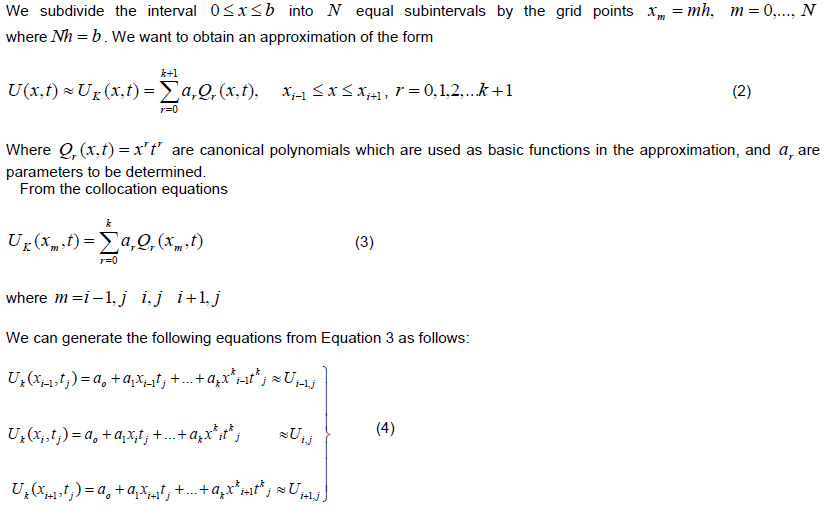
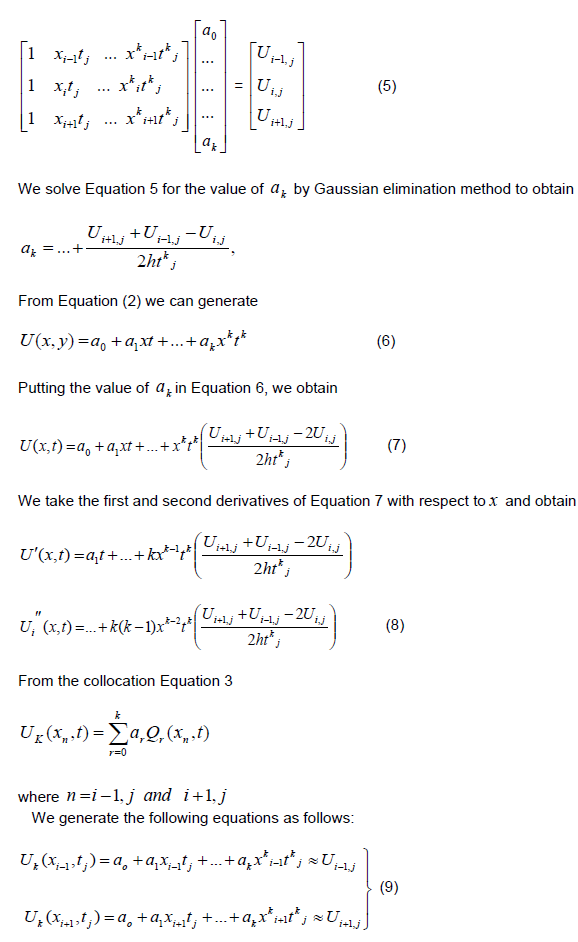

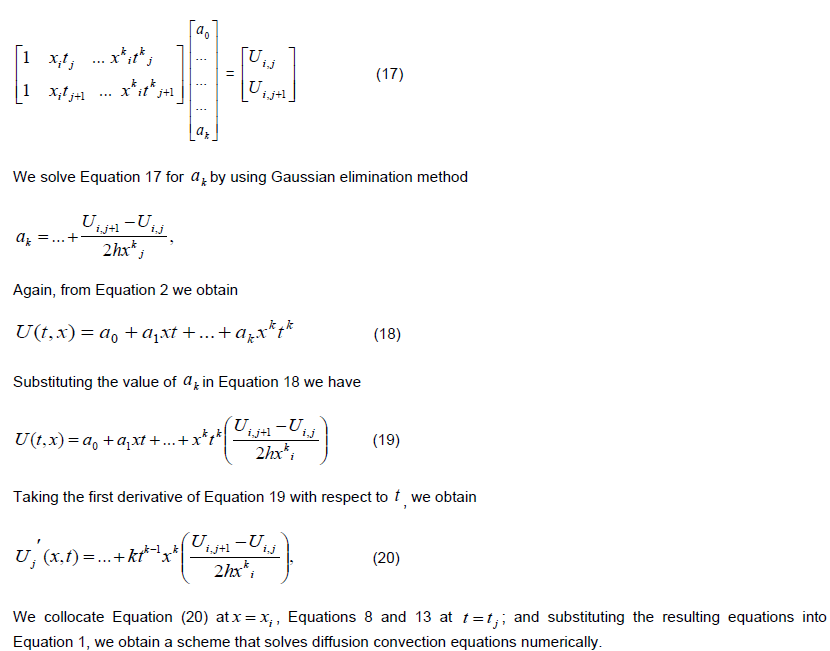
ADVANTAGE OF THE NEW SCHEME OVER FINITE DIFFERENCE METHOD
NUMERICAL EXAMPLES

SPECIFIC PROBLEM
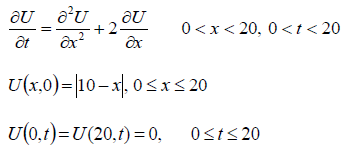
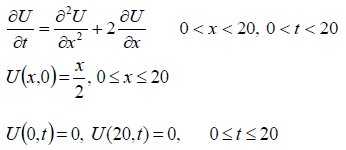
CONCLUSION
CONFLICT OF INTERESTS
REFERENCES
|
Adam A, David R (2002). One dimensional heat equation. |
|
|
Awoyemi DO (2002). An Algorithmic collocation approach for direct solution of special fourth–order initial value problems of ordinary differential equations. J. Nigerian Association of Math. Phys. 6:271-284. |
|
|
Awoyemi DO (2003). A p-stable linear multistep method for solving general third order Ordinary differential equations. Int. J. Comput. Math. 80(8):987-993. |
|
|
Bao W, Jaksch P, Markowich PA (2003). Numerical solution of the Gross – Pitaevskii equation for Bose – Einstein condensation. J. Compt. Phys. 187(1):318-342. |
|
|
Benner P, Mena H (2004): BDF methods for large scale differential Riccati equations. Proc. of Mathematical theory of network and systems. MTNS. Edited by Moore, B. D., Motmans, B., Willems, J., Dooren, P.V. & Blondel, V. |
|
|
Bensoussan A, Da Prato G, Delfour M, Mitter S (2007). Representation and control of infinite dimensional systems. 2nd edition. Birkhauser: Boston, MA. |
|
|
Motmans B, Willems J, Dooren PV, Blondel V, Biazar J, Ebrahimi H (2005). An approximation to the solution of hyperbolic equation by a domain decomposition method and comparison with characteristics method. Appl. Math. Comput.163:633-648. |
|
|
Brown PLT (1979). A transient heat conduction problem. AICHE J. 16:207-215. |
|
|
Chawla MM, Katti CP (1979). Finite difference methods for two-point boundary value problems involving high-order differential equations. BIT. 19:27-39. |
|
|
Cook RD (1974). Concepts and Application of Finite Element Analysis: NY: Wiley Eastern Limited. |
|
|
Crandall SH (1955). An optimum implicit recurrence formula for the heat conduction equation. Q. Appl. Math. 13(3):318-320. |
|
|
Crane RL, Klopfenstein RW (1965). A predictor – corrector algorithm with increased range of absolute stability. JACM 12:227-237. |
|
|
Crank J, Nicolson P (1947). A practical method for numerical evaluation of solutions of partial differential equations of heat conduction type. Proc. Camb. Phil. Soc. 6:32-50. |
|
|
Dahlquist G, Bjorck A (1974). Numerical methods. NY: Prentice Hall. |
|
|
Dehghan M (2003). Numerical solution of a parabolic equation with non-local boundary specification. Appl. Math. Comput. 145, 185-194. |
|
|
Dieci L (1992). Numerical analysis. SIAM J. 29(3):781-815. |
|
|
Douglas J (1961). A survey of numerical methods for parabolic differential equations in advances in computer II. Academic Press. D' Yakonov, Ye G (1963). On the application of disintegrating difference operators. USSR Computational Mathematics and Mathematical Physics, 3(2):511-515. |
|
|
Eyaya BE (2010). Computation of the matrix exponential with application to linear parabolic PDEs. |
|
|
Fox L (1962). Numerical Solution of Ordinary and Partial Differential Equation. New York: Pergamon. |
|
|
Penzl T (2000). A cyclic low-rank Smith method for large sparse Lyapunov equations. SIAM J. Sci. Comput. 21(4):1401-1418 |
|
|
Pierre J (2008). Numerical solution of the dirichlet problem for elliptic parabolic equations. SIAM J. Soc. Ind. Appl. Math. 6(3):458-466. |
|
|
Richard LB, Albert C (1981). Numerical analysis. Berlin: Prindle, Weber and Schmidt, Inc. |
|
|
Richard L, Burden J, Douglas F (2001). Numerical analysis. Seventh ed., Berlin: Thomson Learning Academic Resource Center. |
|
|
Saumaya B, Neela N, Amiya YY (2012). Semi discrete Galerkin method for equations of Motion arising in Kelvin – Voitght model of viscoelastic fluid flow. J. Pure Appl. Sci. 3(2 & 3):321-343. |
|
|
Yildiz B, Subasi M (2001). On the optimal control problem for linear Schrodinger equation. Appl. Math. Comput.121:373-381. |
|
|
Zheyin HR, Qiang X (2012). An approximation of incompressible miscible displacement in porous media by mixed finite elements and symmetric finite volume element method of characteristics. Appl. Math. Computat. Elsevier 143:654-672. |
|
Copyright © 2024 Author(s) retain the copyright of this article.
This article is published under the terms of the Creative Commons Attribution License 4.0